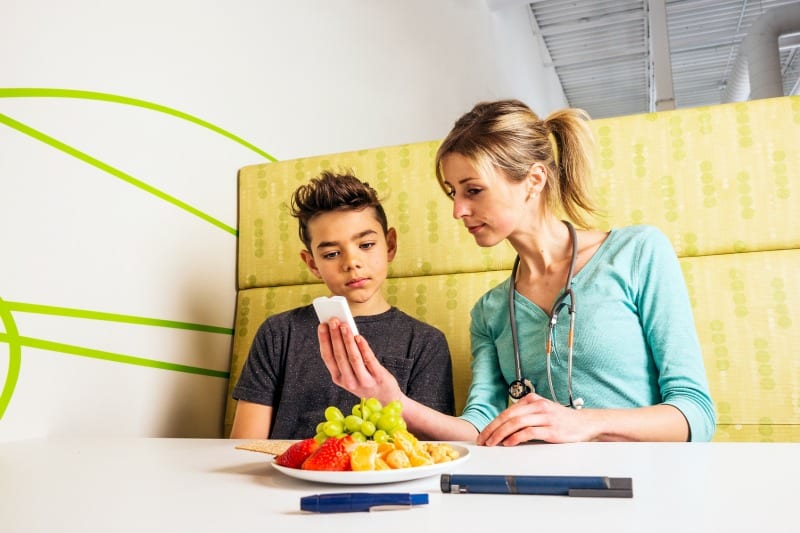As an educator, you provide an extremely important set of eyes and ears for students. Since you see them throughout the day, you notice when things are different, off or just not quite right. This is incredibly helpful and comforting to parents because teachers often uncover important and even life-changing discoveries. Type 1 diabetes (T1D) is one of those diseases that teachers can often see signs of in the classroom, so it’s important to know what to look for. Take a look at some of these warning signs, and also get tips about how to accommodate a child with T1D in your classroom.
1. Type 1 diabetes is an autoimmune disease.
It is not related to lifestyle, nor is it the result of anything the child (or family) did or did not do. Normally, the pancreas produces insulin, a hormone that helps the body use glucose (“blood sugar”) for energy. In people who have T1D, the body’s immune system attacks the insulin-producing cells and the pancreas produces very little or no insulin, so blood sugar levels can rise if unchecked. A person with T1D needs insulin injections or infusions to live.
2. Excessive urination, thirst and hunger are all symptoms of T1D.
Because teachers spend so much time with kids, they may be among the first to notice symptoms that could be linked to diabetes. A child who is asking to use the bathroom and get drinks frequently may not be just trying to get out of class—they might have diabetes. If you notice any unusual symptoms, mention them to the parents and school nurse so they can be evaluated.
3. Children with diabetes need to eat throughout the day.
People with diabetes keep their blood glucose at healthy levels by carefully balancing their food intake with insulin injections or infusions. Those inputs of food and insulin are carefully timed, and if the food/insulin equation is off, the person may suffer hyperglycemia (high blood sugar) or hypoglycemia (low blood sugar). A child with diabetes may need a midmorning or afternoon snack to keep their glucose level stable. They might also need quick access to glucose or sugar such as candy, juice or another fast-acting sugar if their blood sugar starts to drop. That’s why kids with T1D are allowed to have snacks in class, even when other children cannot.
4. Sugary snacks aren’t completely off-limits.
A nutritious, well-balanced diet is essential for long-term blood sugar control, but that doesn’t mean that kids with diabetes can’t eat cake, cookies or other special treats. With a little preplanning and communication with parents, children with T1D can have these types of foods. “As long as children take the appropriate amount of insulin, they are allowed to eat anything their peers eat,” says Kathy Thomas, a Wisconsin resident and mother of a 9-year-old son with T1D. “Please don’t leave them out of class parties. That only leads to hurt feelings.”

Fancy chocolate cupcakes with vanilla cream and colorful toppings and decoration
5. Children are legally allowed to carry their testing and treatment supplies with them.
Some insulin pumps look and sound like cell phones, and some people with diabetes use smartphones to control their insulin pumps and track blood glucose levels. Take some time to familiarize yourself with the equipment your student uses to manage their disease, and allow them to check whenever they feel the need. Failure to do so can be dangerous and can damage the relationship between student and teacher as well as the caregiver and teacher.
6. High or low blood sugars can alter cognition and behavior.
A child whose blood sugar is out of their recommended range “might seem belligerent, stubborn or out of it,” says Theresa Sullivan Barger, mother of a teenage son who was diagnosed with T1D at age 14. If you notice any behavior that’s out of character for your student, suggest a blood sugar check.
7. Hyper- and hypoglycemia require immediate action.
Blood sugar levels that are too high or too low are a medical emergency. Without appropriate treatment, the situation can turn critical in a hurry. All students with diabetes should have an emergency-care plan filed with the school nurse. It’s a good idea to review the plan, in person, with the student, caregiver and school nurse at the beginning of the school year or as soon as you learn of your student’s diagnosis.
8. Someone should accompany a child with low blood sugar to the school nurse.
“When your blood sugar is dropping, you can’t think clearly; it affects cognitive functioning,” says Susan Hoffmann, RN and education program manager for the National Association of School Nurses. “There have been scenarios where students have been sent to the nurse and they’ve turned in the wrong direction and been found wandering.”
9. Students with diabetes are eligible for a Section 504 plan.
Diabetes counts as a disability, and like other children with disabilities, children with T1D are entitled to accommodations to access the regular curriculum. Those accommodations may include permission to have snacks in the classroom and to leave the classroom as needed. Academic accommodations may include the opportunity to delay testing if blood sugar is too high or low (remember, high or low blood sugar affects thinking) and retake the test when the blood sugar is stable.
10. T1D is an unpredictable disease.
“Everyone’s body is different, and even if you do everything you should, you can still wake up in the morning with low blood sugar,” says Janet Davenport, a mom with a child who grew up with T1D. These unexpected complications are an emotional, physical and financial toll for families. Know that families cannot predict when crises or challenges will occur, and be understanding of unexpected absences and incomplete assignments.
11. A little compassion and understanding go a long way.
“Have high expectations for your students with diabetes, but also have a measure of grace,” Thomas says. “So much of a diabetic’s life is out of their control, so never make them feel bad for how their diabetes affects their behavior or effort in school.”
12. Stress, illness, exercise and excitement can affect blood sugar levels.
Stress and illness can cause blood sugar levels to skyrocket. Exercise can lead to low blood sugar. Excitement can cause blood sugar to spike or fall, depending on the child and circumstance. If the school day has been less than routine, watch your student carefully for signs of hypo- or hyperglycemia—such as lethargy, irritability, sweating and confusion—and encourage and support the child’s efforts to check and manage their blood sugar.
13. Students have a right to confidentiality and privacy.
Many students and their families wish to create awareness about T1D and encourage empathy. However, “some students don’t want anyone else in the classroom to know, and that’s their right,” Hoffmann says. “Unless permission is given by the child and their family, teachers should not share information about the student’s health with anyone except those who have an educational need to know.”


